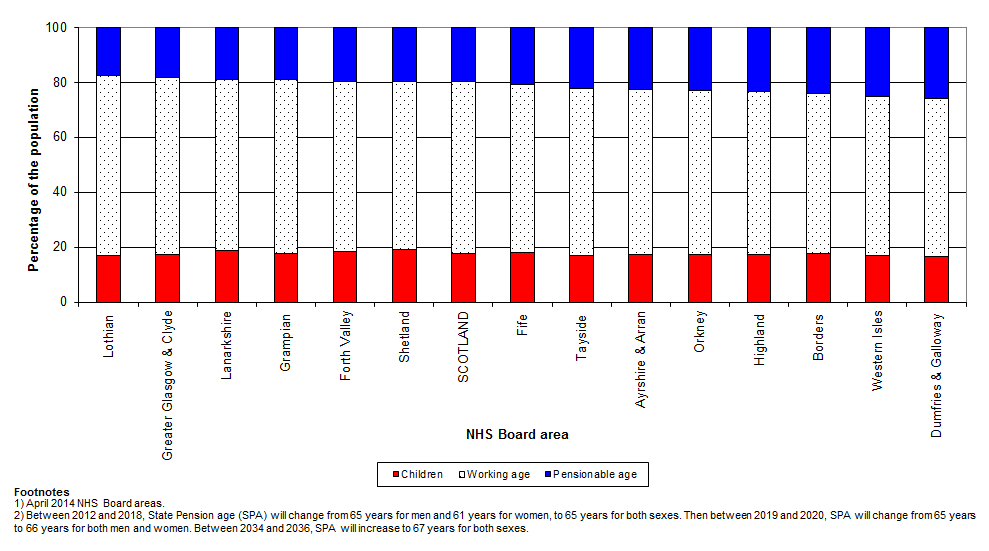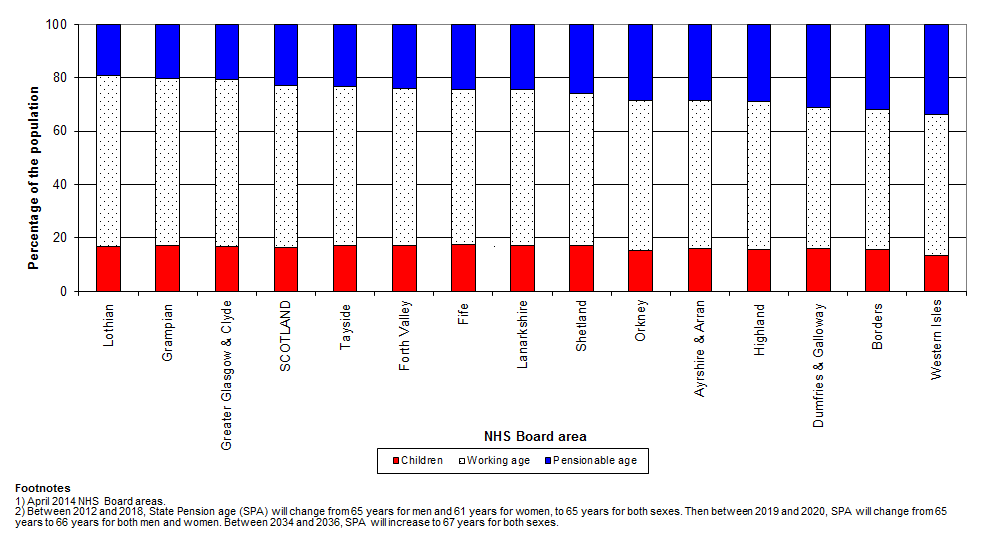3.1.1 The results of the 2012-based projections show the total population of Scotland rising from 5.31 million in 2012 to 5.78 million in 2037, and continuing to rise in the future. Figure 1 shows the results for Scotland for 25 years ahead, up to 2037.

3.1.2 A key point is that, in parallel with the projected rise in the size of the population over the next 25 years, Scotland’s population is projected to age markedly.
3.1.3 Further details on the national population projection results are available within the Projected Population of Scotland (2012-based) section of the of the National Records of Scotland (NRS) website.
3.2.1 The populations of 20 of the 32 Council areas in Scotland are projected to increase and 12 to decrease by 2037 as shown in Table 1. The map at Figure 2a and the chart at Figure 2b show the projected percentage change in population between 2012 and 2037 for each Council area. City of Edinburgh and Aberdeen City are projected to have a relatively large increase compared with other large urban areas, for example Glasgow City and Dundee City. Other areas in the west, such as Inverclyde, Argyll & Bute, and East and West Dunbartonshire and are all projected to decline.
3.2.2 The Council areas which are projected to show the largest relative increases over this period are City of Edinburgh and Aberdeen City (both +28 per cent), Perth & Kinross (+24 per cent), and East Lothian (+23 per cent). The largest relative population decreases are projected in Inverclyde (-19 per cent), Argyll & Bute (-13 per cent) and Eilean Siar (-11 per cent). Table 3 shows the projected percentage change in population for selected years.
3.2.3 The overall projected population change is a result of a combination of natural change (the difference between the number of births and deaths) and migration. The relative importance of each factor differs between areas. Table A compares the projected rates of natural change and migration across Council areas between 2012 and 2037. In most areas of projected population increase, it is due to increases through natural change and migration, but Orkney Islands, Highland, South Lanarkshire, Renfrewshire the population gain over this 25 year period is attributable to gains from migration alone. North Lanarkshire is the only Council area where the population is projected to increase due to more births than deaths despite net out-migration.
3.2.4 Similarly some areas of projected population decline, such as Inverclyde, Argyll & Bute , North Ayrshire, West Dunbartonshire and East Dunbartonshire are projected to experience decreases from both migration and natural change. In Clackmannanshire the projected population decline is due to net out-migration despite slightly more births than deaths. In contrast, in areas such as Eilean Siar, South Ayrshire, Dumfries & Galloway, Angus and East Ayrshire, the population decline is due to more deaths than births despite net in-migration.
| Area | Natural change1 | Net migration2 | Percentage projected population change |
|---|---|---|---|
Footnotes:
| |||
| Scotland | 1.6 | 7.2 | 8.8 |
| Council areas sorted3 | |||
| Inverclyde | -9.7 | -9.7 | -19.4 |
| Argyll & Bute | -10.4 | -3.1 | -13.5 |
| Eilean Siar | -14.2 | 3.4 | -10.8 |
| North Ayrshire | -6.0 | -2.8 | -8.8 |
| West Dunbartonshire | -2.5 | -5.5 | -8.1 |
| East Dunbartonshire | -4.4 | -2.4 | -6.8 |
| Dumfries & Galloway | -7.6 | 1.5 | -6.1 |
| South Ayrshire | -8.8 | 6.4 | -2.4 |
| Clackmannanshire | 0.0 | -2.4 | -2.4 |
| Moray | -2.2 | 0.0 | -2.2 |
| Angus | -5.0 | 4.2 | -0.8 |
| East Ayrshire | -2.6 | 2.0 | -0.6 |
| Scottish Borders | -6.5 | 6.5 | 0.0 |
| North Lanarkshire | 1.3 | -1.2 | 0.1 |
| Renfrewshire | -0.8 | 1.4 | 0.6 |
| South Lanarkshire | -1.2 | 3.5 | 2.3 |
| East Renfrewshire | 0.9 | 2.7 | 3.7 |
| Highland | -2.8 | 7.4 | 4.5 |
| Orkney Islands | -4.9 | 10.5 | 5.5 |
| Shetland Islands | 3.0 | 5.4 | 8.3 |
| Fife | 1.7 | 7.0 | 8.7 |
| Falkirk | 2.5 | 7.9 | 10.4 |
| West Lothian | 9.1 | 2.7 | 11.7 |
| Glasgow City | 7.5 | 7.6 | 15.1 |
| Dundee City | 6.4 | 9.2 | 15.6 |
| Stirling | 2.9 | 13.4 | 16.3 |
| Aberdeenshire | 5.2 | 12.2 | 17.3 |
| Midlothian | 5.9 | 11.7 | 17.6 |
| East Lothian | 6.0 | 17.4 | 23.3 |
| Perth & Kinross | 1.4 | 22.7 | 24.2 |
| Edinburgh, City of | 8.3 | 20.0 | 28.2 |
| Aberdeen City | 9.2 | 19.2 | 28.4 |
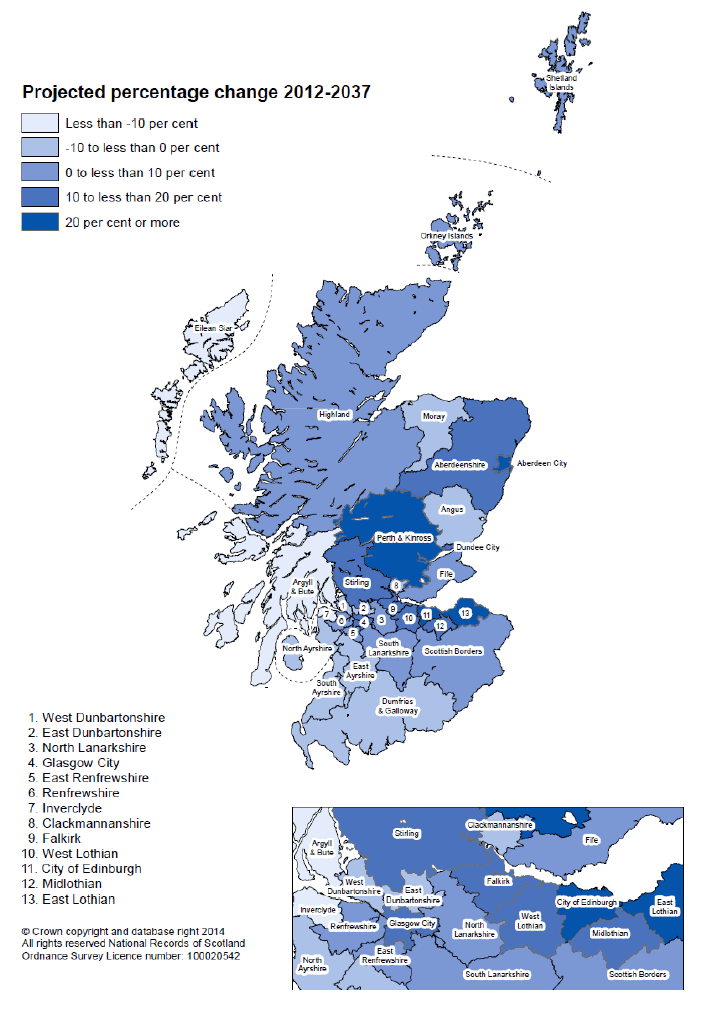
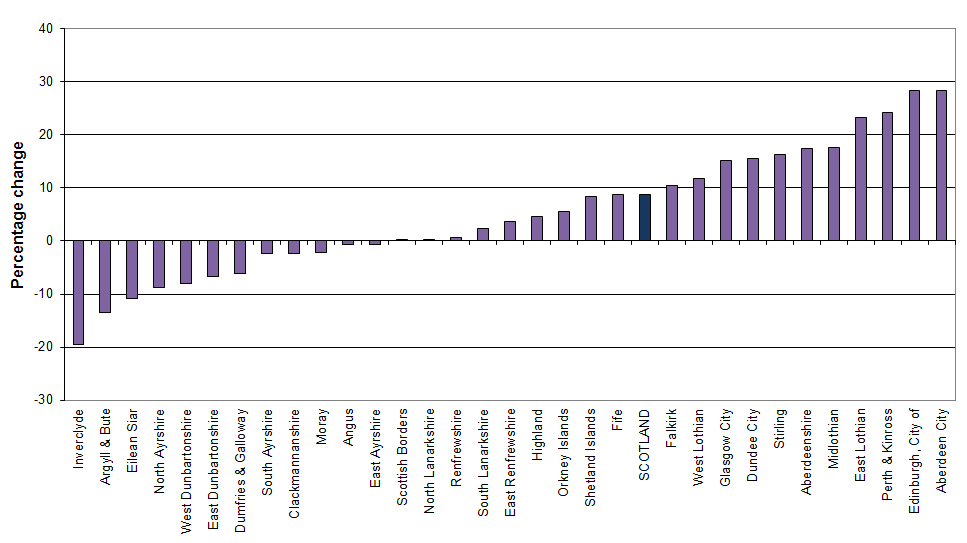
3.3.1 There are also differences in the size of the projected changes in the populations of NHS Board areas over the next 25 years. This is illustrated in the map at Figure 3a and the chart at Figure 3b, both of which show the projected percentage change in the population of NHS Board areas between 2012 and 2037 for the new April 2014 NHS Board boundaries. For more information on the new boundaries please go to Section 1.
3.3.2 Ten of the NHS Board areas are projected to increase and four to decrease. The areas with the largest relative projected increases are Lothian (+23 per cent), Grampian (+18 per cent), and Tayside (+14 per cent). The areas with projected decreases are Western Isles (-11 per cent), Dumfries & Galloway (-6 per cent), and Ayrshire & Arran (-4 per cent). Table 3 shows the projected percentage change in population for selected years.
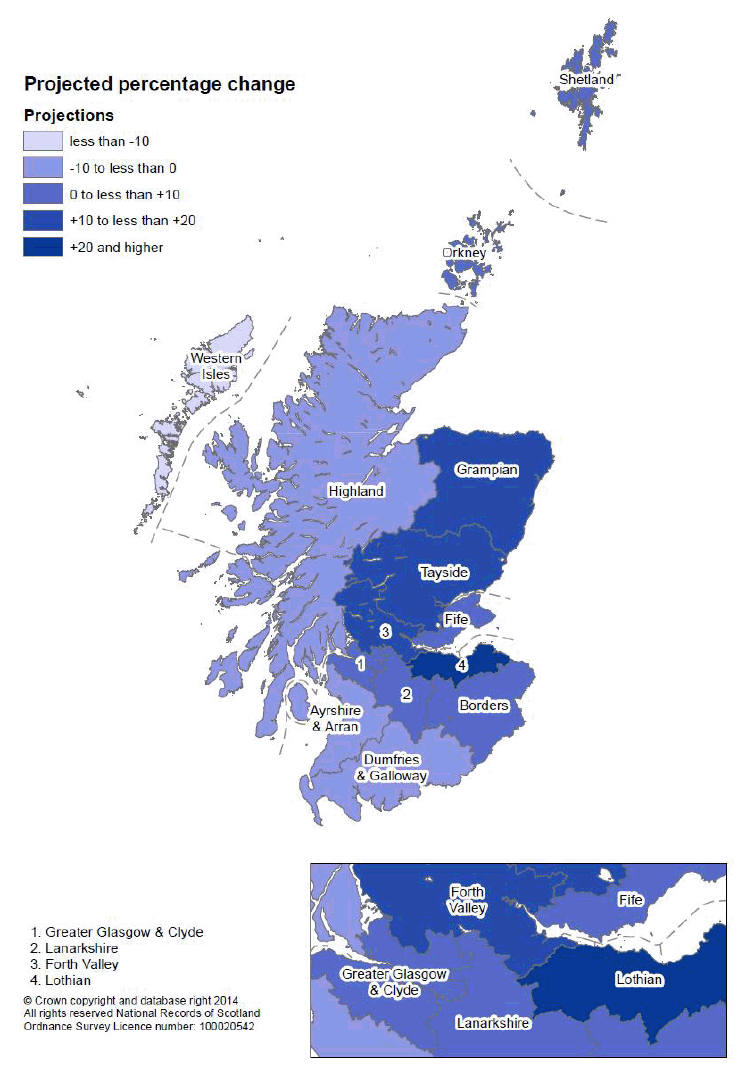
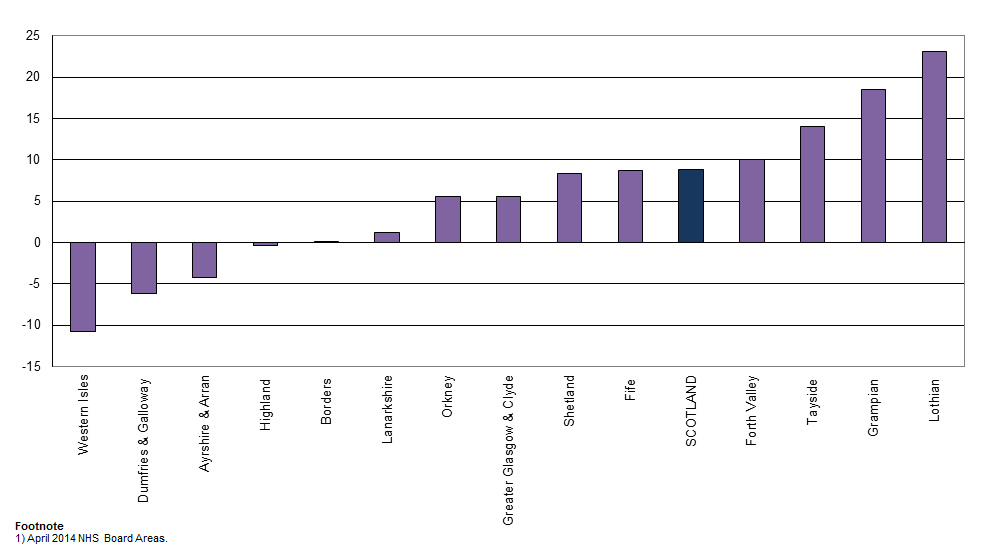
3.4.1 As well as wide differences in the projected size of the population for different areas, there are large differences in the projected age structure. Table 2 gives detailed population projections by age group, and Table 3 gives the changes for selected age bands. For Scotland as a whole, the number of children aged 0-15 is projected to increase by five per cent from 0.91 million in 2012 to 0.96 million by 2037. The number of people of working age is projected to increase by four per cent from 3.35 million to 3.48 million, and the number of people of pensionable age to increase by 27 per cent from 1.05 million to 1.33 million.
3.4.2 Working age and pensionable age populations based on State Pension Age (SPA) for a given year. Between 2012 and 2018, SPA will change from 65 years for men and 61 years for women, to 65 years for both sexes. Then between 2019 and 2020, SPA will change from 65 years to 66 years for both men and women. Between 2034 and 2036, SPA will increase in to 67 years for both sexes. This is based on SPA under the 2011 Pensions Act.
3.4.3 The number of children aged 0-15 is projected to increase in 12 of the 32 Council areas by 2037. The largest relative increases are projected in Aberdeen City (+45 per cent), East Lothian (+28 per cent), City of Edinburgh (+27 per cent) and Perth & Kinross and Dundee City (both +26 per cent). The largest declines are projected for Inverclyde (-32 per cent), Eilean Siar (-28 per cent), and Argyll & Bute (-18 per cent) as shown in Figure 4a.
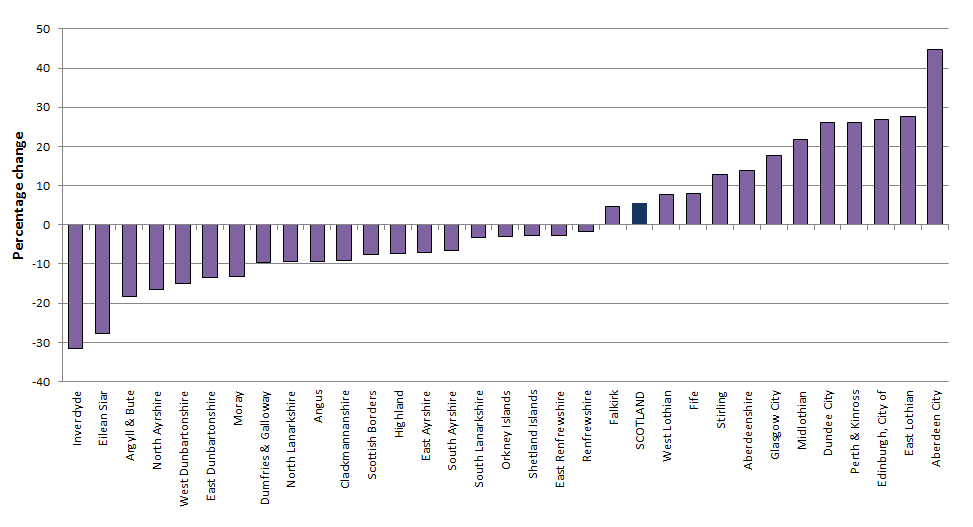
3.4.4 There are also differences in the size of the working age population projected for 2037 for Council areas. Figure 4b and Table 3 show the percentage change in the working age population between 2012 and 2037, and include the change in state pension age as set out in the 2011 Pensions Act. Of course this is the state retirement age and in practice people will retire at a range of ages. The working age population is projected to increase in 13 Council areas by 2037, increasing the most in City of Edinburgh (+28 per cent), Aberdeen City (+26 per cent) and Perth & Kinross (+22 per cent), and a decrease is projected in the remaining 19 Council areas ranging from a decrease of -29 per cent in Inverclyde to –1 per cent in Orkney Islands.
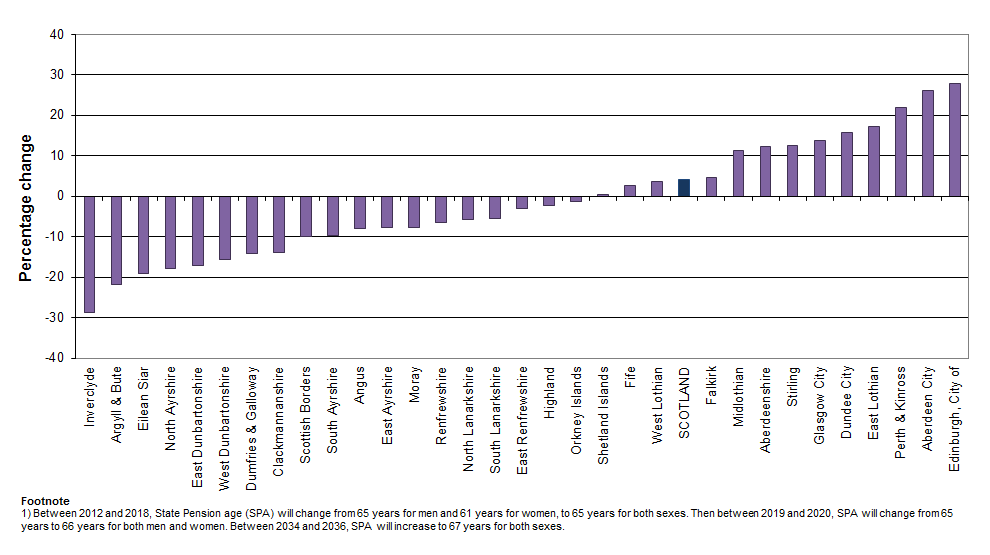
3.4.5 There are also differences between Council areas in terms of the projected percentage change in the population of pensionable age (taking into account the change in state retirement age), as Figure 4c shows. The population of pensionable age is projected to increase in all Council areas by 2037. The largest relative increases are projected to be in West Lothian (+47 per cent) Shetland Isles (+44 per cent) and Clackmannanshire (+40 per cent).
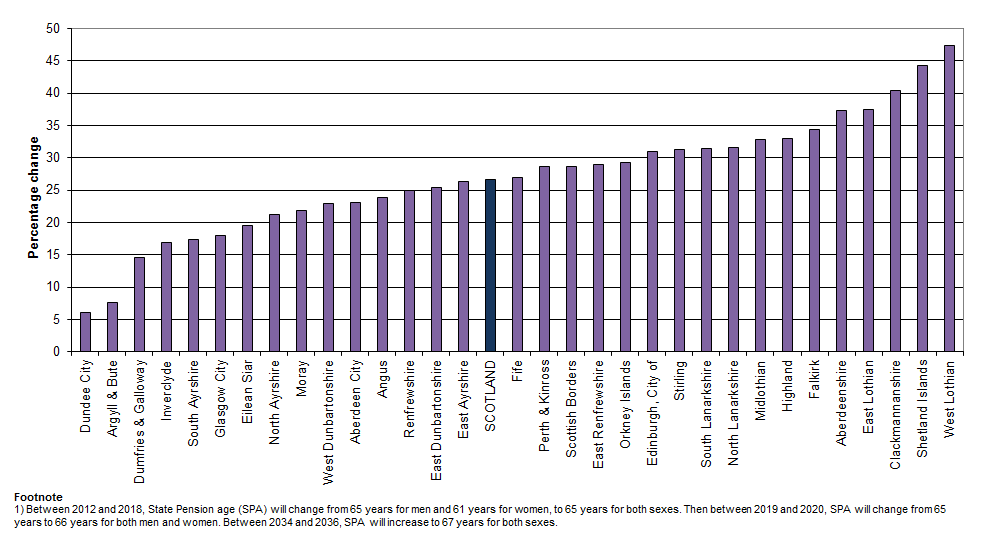
3.4.6 By 2037 the Scottish population aged 75 and over is projected to increase by 86 per cent. It is assumed to increase in all Council areas, ranging from a projected increase of 45 per cent in Dundee City to a projected increase of 140 per cent in West Lothian, as shown in Figure 4d.
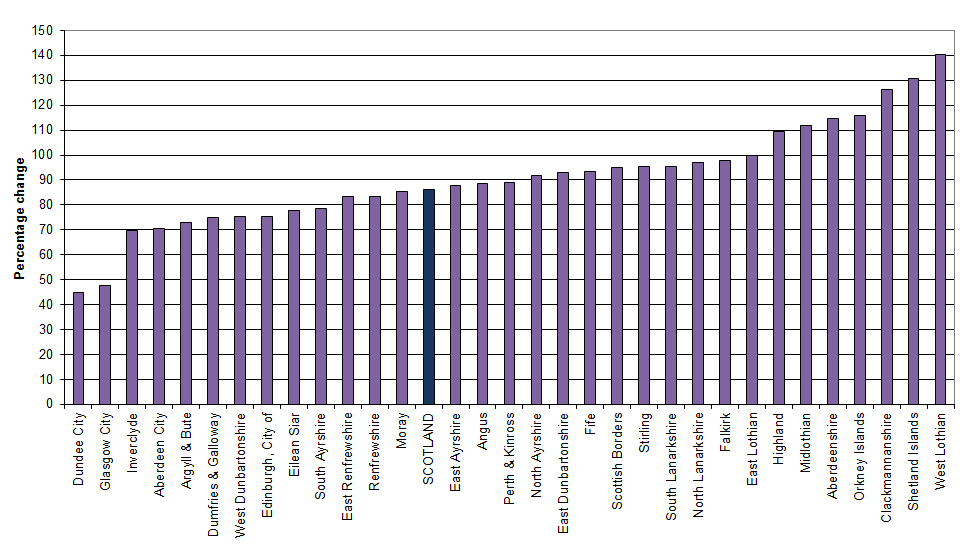
3.4.7 There are similar variations by NHS Board area (April 2014 boundaries). Figure 5a, Figure 5b, Figure 5c and Figure 5d show the projected percentage change in the number of children (aged 0-15), people of working age, people of pensionable age, and people aged 75 and over, by NHS Board areas. The number of children is projected to decrease in eight of NHS Board areas (Western Isles, Ayshire & Arran, Highland, Dumfries & Galloway, Borders, Lanarkshire, Orkney and Shetland) and to increase in the other NHS Board areas. The population of working age is projected to decrease in half of the 14 NHS Board areas (Western Isles, Ayrshire & Arran, Dumfries & Galloway, Borders, Highland , Lanarkshire, and Orkney) and to increase in the others. The population of pensionable age is projected to increase in all NHS Board areas, ranging from an increase of 15 per cent in Dumfries & Galloway to 44 per cent in Shetland. The population of people aged 75 and over is also projected to increase in all NHS Board areas, with the largest projected increase in Shetland (+131 per cent), and the smallest increase in Greater Glasgow & Clyde (+66 per cent).
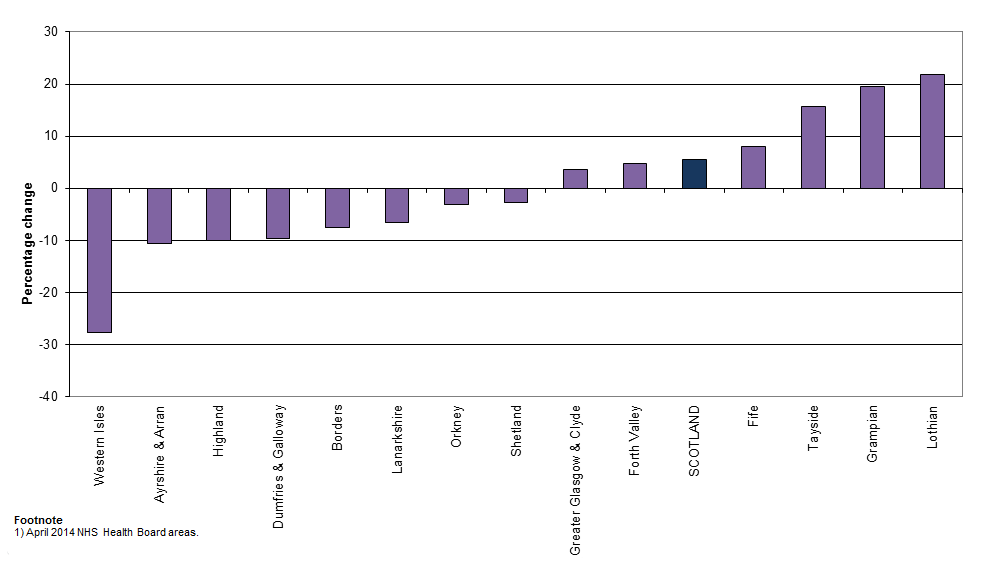
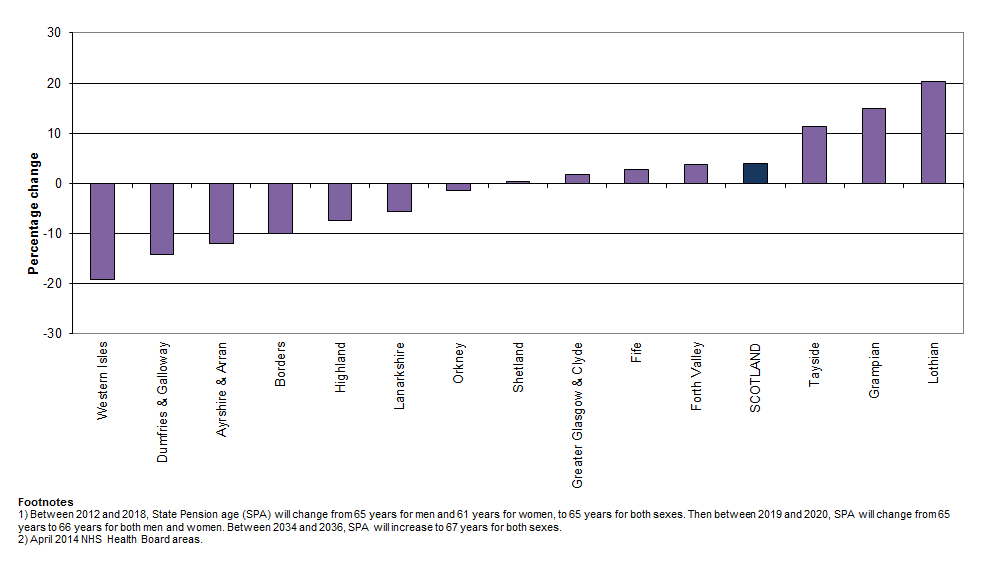
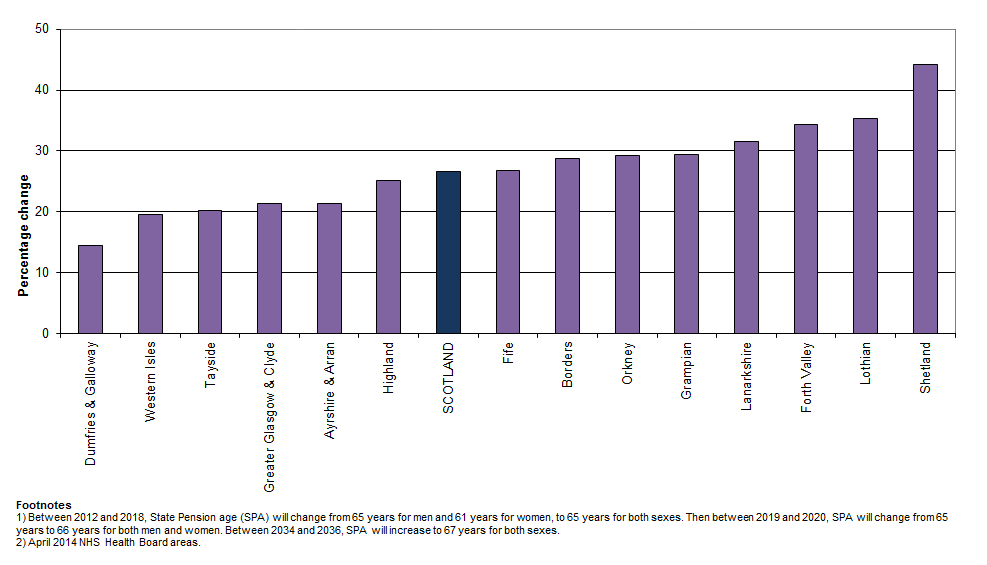
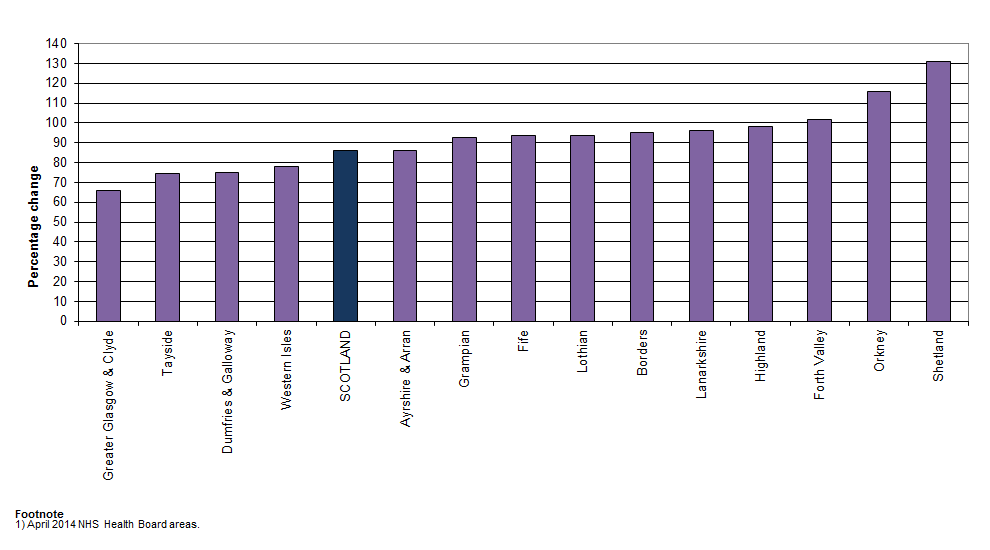
3.4.8 Table B summarises these changes, moving from the area with the greatest projected population decrease (Inverclyde) to the area with the largest increase (Aberdeen City). In general the decreases in population are largely associated with large decreases in children and working age population, while increases are mostly associated with large increases in the pensionable aged population except for Dundee City where the increases are mostly from children and people of working age.
| Area | All ages | Children (0-15) | Working Ages1 | Pensionable Ages2 |
|---|---|---|---|---|
Footnotes:
| ||||
| Scotland | 8.8 | 5.5 | 4 | 26.7 |
| Council areas sorted2 | ||||
| Inverclyde | -19.4 | -31.6 | -28.7 | 16.9 |
| Argyll & Bute | -13.5 | -18.3 | -21.7 | 7.5 |
| Eilean Siar | -10.8 | -27.6 | -19.1 | 19.6 |
| North Ayrshire | -8.8 | -16.5 | -17.8 | 21.3 |
| West Dunbartonshire | -8.1 | -15 | -15.7 | 22.9 |
| East Dunbartonshire | -6.8 | -13.4 | -17.2 | 25.4 |
| Dumfries & Galloway | -6.1 | -9.5 | -14.3 | 14.5 |
| South Ayrshire | -2.4 | -6.7 | -9.8 | 17.3 |
| Clackmannanshire | -2.4 | -9.2 | -14 | 40.3 |
| Moray | -2.2 | -13.3 | -7.6 | 21.8 |
| Angus | -0.8 | -9.4 | -8.1 | 23.8 |
| East Ayrshire | -0.6 | -7.1 | -7.8 | 26.3 |
| Scottish Borders | 0 | -7.5 | -10.1 | 28.7 |
| North Lanarkshire | 0.1 | -9.4 | -5.9 | 31.6 |
| Renfrewshire | 0.6 | -1.8 | -6.5 | 25 |
| South Lanarkshire | 2.3 | -3.2 | -5.5 | 31.5 |
| East Renfrewshire | 3.7 | -2.7 | -3.1 | 28.9 |
| Highland | 4.5 | -7.2 | -2.4 | 32.9 |
| Orkney Islands | 5.5 | -3.1 | -1.3 | 29.3 |
| Shetland Islands | 8.3 | -2.8 | 0.4 | 44.2 |
| Fife | 8.7 | 7.9 | 2.7 | 26.9 |
| Falkirk | 10.4 | 4.7 | 4.6 | 34.4 |
| West Lothian | 11.7 | 7.7 | 3.7 | 47.3 |
| Glasgow City | 15.1 | 17.7 | 13.8 | 18 |
| Dundee City | 15.6 | 26 | 15.8 | 6.1 |
| Stirling | 16.3 | 12.7 | 12.5 | 31.2 |
| Aberdeenshire | 17.3 | 13.8 | 12.2 | 37.3 |
| Midlothian | 17.6 | 21.8 | 11.3 | 32.9 |
| East Lothian | 23.3 | 27.5 | 17.1 | 37.4 |
| Perth & Kinross | 24.2 | 26 | 21.9 | 28.7 |
| Edinburgh, City of | 28.2 | 27 | 27.9 | 30.9 |
| Aberdeen City | 28.4 | 44.8 | 26.2 | 23.1 |
3.4.9 The preceding paragraphs describe the projected percentage change by administrative area. It is also useful to look at the existing and projected age structure of the different areas. Figure 6a and Figure 6b, and Figure 7a and Figure 7b show the proportion of the population who are children (aged 0-15), of working age and of pensionable age in 2012 and 2037 for Council and NHS Board areas respectively. The projected proportion of the population of Scotland of pensionable age increases from 20 per cent in 2012 to 23 per cent in 2037. The pattern is similar in nearly all areas. Amongst Council areas in 2012, Argyll & Bute and Dumfries & Galloway (both 26 per cent) along with Eilean Siar, South Ayrshire and Scottish Borders (all 25 per cent) ,have the highest proportions of people of pensionable age, and Glasgow City (16 per cent), West Lothian, City of Edinburgh and Aberdeen City (all 17 per cent) the lowest. The picture is similar by 2037. Eilean Siar is projected to have the highest percentage of pensioners (34 per cent) by this time, followed by Argyll & Bute (33 per cent). By 2037 the Council areas projected to have the lowest proportion of pensioners are Aberdeen City, Glasgow City (both 16 per cent), and Edinburgh, City of (17 per cent).
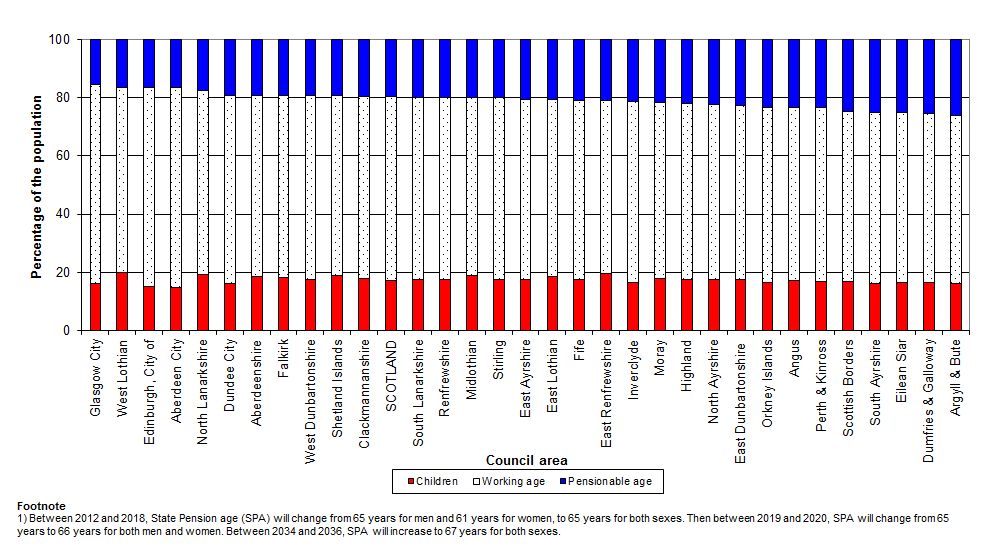
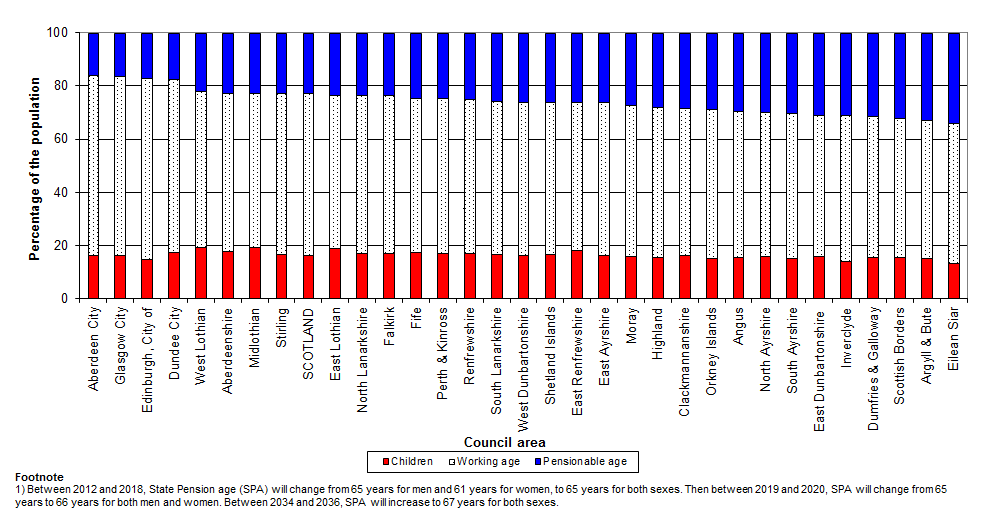
3.4.10 For NHS Board areas a comparable pattern can be seen. In 2012, Dumfries & Galloway NHS Board area has the highest proportion of its population of pensionable age (26 per cent), but by 2037, Western Isles is projected to have the highest proportion at 34 per cent, followed by Borders (34 per cent). The area with the lowest proportion of population of pensionable age in 2012 is Lothian (18 per cent), and in 2037 the proportion of pensionable age is still lowest in Lothian (19 per cent). A key point from all four charts is that the population in nearly all areas is projected to age by 2037, and it is important to note that the existing age structure of the area in the base year has an impact on the age structure for future years.
